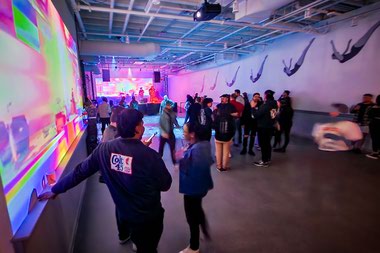Seven years ago, local artist Kristine McCallister began to explore the potential for integrating paper dolls into her mixed media work. Combining newspaper clippings addressing global headlines like Hurricane Katrina and the Iraq War with juvenile old-world paper figures, the artist developed a visual vocabulary that zeroes in on the jarring imbalance between sheltered youth and the harsh realities of adulthood.
McCallister’s investigation culminates in Coming of Age, a collection of psychologically curious paintings on view at Brett Wesley Gallery.
Few of us pass through adolescence unscathed, and the splintering of our youthful selves can be almost physically painful. In McCallister’s oeuvre, this fragmentation is rendered a quite real consequence of growing up and formally expressed through the segmented splicing of figures. The paper dolls’ features are drawn or the profile traced repeatedly across the surface of the canvas. McCallister almost never depicts a full figure, instead slicing them into halves or thirds that penetrate the field of vision from every possible angle. The lack of identifiable pattern or purpose has the feel of glimpsing into a shattered mirror.
The Details
- Coming of Age
- Through May 26; Tuesday-Saturday, noon-6 p.m.; free
- Brett Wesley Gallery, 1112 S. Casino Center Blvd., 433-4433

Works like “Breaking Old Patterns” or “Echoes” are particularly striking. Layers of clothing patterns create a translucent-brown, aged surface, into which McCallister draws the paper doll figures floating unmoored, creating a restrained palette. The alluring and occasionally quite dense graphite lends a nervous and fragile energy. Significantly, “Echoes” incorporates layers of cardboard carved out with complete profiles of the doll, revealing segments of the painting below. Representative of similar instances in other paintings, the only complete figures depicted throughout the exhibition are cut away from cardboard or painted like shadows. These vulnerable, ghostly shapes suggest the spectre of innocence still looming inside the adult psyche.
The visual trope of fragmentation isn’t the freshest take on psychological trauma. Although effective, it feels a bit dated and unoriginal. A more innovative use of the technique would generate a contemporary relevance missing from the paintings. The work is consistent and thoughtful, but disappointingly familiar.
McCallister’s best efforts are self-contained psychological portraits. Take “Gina Gina,” a small painting featuring the partial rendering of a paper doll in repetition. Outlined in pinks and reds, her feet are rooted to little tufts of acid green grass. Alternately facing forward and back, the figure literally looks onto and slides into herself.
To her credit, McCallister’s use of older paper dolls from the early 20th century visually complements this splintered strategy, the dream-like perception of a warped dimension. Less politically charged than earlier efforts in the series, the work also sidesteps mourning the loss of youthful naïveté. While nostalgic, it favors the intellectual over the sentimental.







Previous Discussion: